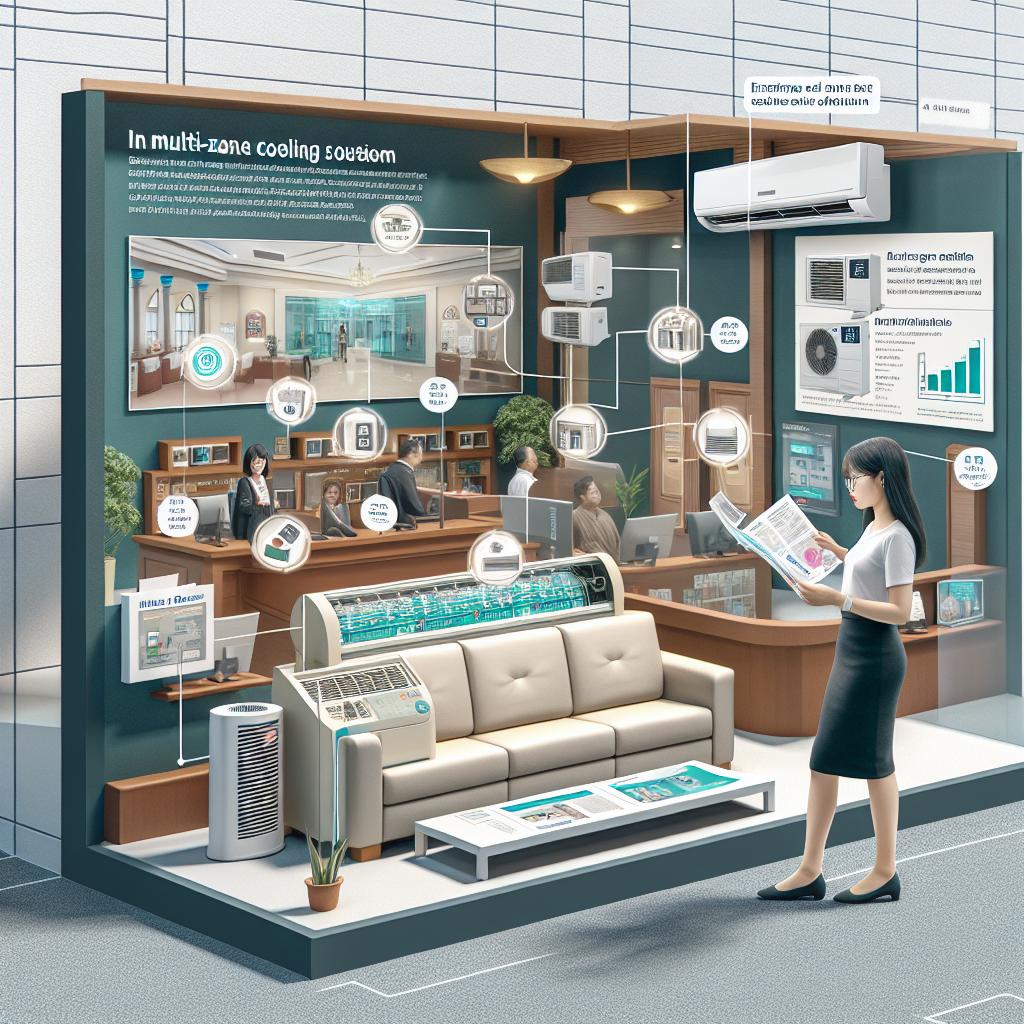As temperatures rise and the demand for comfortable indoor environments grows, financial institutions and banks are increasingly recognizing the importance of effective climate control solutions. Among the most efficient and adaptable systems available today are mini split air conditioners, which promise to deliver targeted cooling and enhanced comfort. In this article, we will explore the best practices for planning and implementing mini split AC systems specifically tailored for the unique needs of financial institutions. From understanding the benefits of these systems to navigating installation considerations, we will guide you through each step of the process, ensuring that your institution is not only a haven of comfort for employees and clients alike, but also a model of energy efficiency. Join us as we delve into the world of mini split AC solutions and discover how they can be a game changer for financial environments.
Choosing the Right Mini Split AC System for Financial Institutions
When selecting a mini split AC system for financial institutions, it is essential to consider the unique operational needs of the space. Financial institutions often have a variety of areas that require different cooling capacities, such as customer service areas, offices, and server rooms. Here are some key factors to take into account:
- Cooling Capacity: Assess the BTU requirements based on the size of each room and the number of occupants.
- Energy Efficiency: Look for models with high SEER ratings to minimize energy consumption and operating costs.
- Multi-Zone Capability: Choose systems that allow for customized cooling per area for improved comfort and efficiency.
- Noise Levels: Ensure that the system operates quietly, especially in customer-facing areas where a calm atmosphere is crucial.
Additionally, installation and maintenance are vital components in the decision-making process. Consider partnering with experienced HVAC contractors who understand the compliance standards specific to financial institutions. Prioritize systems that offer advanced features such as smart controls and maintenance notifications to enhance usability and reliability. Creating a comparison table can help visualize your options:
| Brand | Cooling Capacity (BTU) | SEER Rating | Noise Level (dB) |
|---|---|---|---|
| Brand A | 12,000 | 22 | 30 |
| Brand B | 18,000 | 20 | 28 |
| Brand C | 24,000 | 21 | 32 |

Designing an Efficient Cooling Layout for Optimal Comfort
Creating a harmonious atmosphere in financial institutions and banks requires careful attention to the cooling layout. Begin by assessing the different zones within the space where the mini split AC systems will be deployed. It’s essential to consider areas like customer service desks, auditoriums, and private offices, as each requires varying cooling levels to ensure optimal comfort. Incorporate a variety of solutions including:
- Strategically placed indoor units to maximize airflow.
- Using smart thermostats to adjust the temperature according to occupancy.
- Segmenting large spaces into smaller zones for tailored cooling.
Moreover, attention should also be given to the outdoor unit installation. Ensure that the units are located in shaded areas to increase efficiency, reducing the load on the system. When considering ductless mini split systems, a careful analysis of the building layout is critical. Take into account:
| Building Area | AC Unit Type | Recommended BTU/h |
|---|---|---|
| Reception Area | Wall-mounted | 12,000 |
| Private Offices | Ceiling-mounted | 9,000 |
| Server Room | Floor-mounted | 18,000 |
This thoughtful approach not only enhances air distribution but also maintains energy efficiency, creating a comfortable atmosphere that fosters productivity. By focusing on an effective cooling layout, financial institutions can ensure their clients and staff experience the utmost comfort, ultimately leading to a more inviting environment.
Installing Mini Split AC Units with Minimal Disruption
Implementing a mini split AC system in financial institutions requires careful planning to ensure that operations remain smooth and undisturbed. Prioritizing convenience and efficiency, contractors can strategically schedule installations during off-peak hours, minimizing the impact on staff and clients. It’s essential to communicate clearly with all stakeholders, letting them know the timeline and any potential disruptions. Simple measures like using existing electrical infrastructure and selecting compact, unobtrusive indoor units can also reduce installation complexity and noise during operation.
Moreover, utilizing advanced technology like multi-zone systems allows for targeted cooling in specific areas, decreasing the need for extensive ductwork and maintaining aesthetics. Key considerations during installation include:
- Careful routing of refrigerant lines and electrical connections to avoid visible disruptions
- Using wall-mounted units to save floor space and enhance customer interaction areas
- Incorporating smart thermostats for monitoring and control without manual adjustments
Employing well-trained technicians who are adept at navigating the unique challenges of financial institutions can further ensure that the process is efficient and minimally invasive.

Maintaining Your Mini Split System for Long-Term Performance
To ensure the longevity and efficiency of your mini split system, regular maintenance is essential. Start by cleaning or replacing the air filters every month during peak usage times. Dirty filters can restrict airflow, causing your system to work harder and consume more energy. Additionally, consider scheduling professional inspections at least once a year, which can help identify potential issues before they escalate. During these inspections, technicians can also check refrigerant levels and inspect the coils, ensuring that your system is operating smoothly.
Furthermore, be proactive in maintaining the exterior components of your mini split system. Keep the outdoor unit free from debris, leaves, and snow accumulation to facilitate proper airflow. It’s also wise to inspect the insulation on refrigerant lines to prevent energy loss, which can significantly impact your cooling efficiency. Implementing these simple yet effective measures can dramatically enhance the performance of your mini split system over the long term, ultimately contributing to a comfortable and productive environment.
Q&A
Q&A: How to Plan and Implement Mini Split AC for Cooling and Comfort in Financial Institutions and Banks
Q1: What exactly is a mini split AC system and why is it suitable for financial institutions and banks?
A1: A mini split AC system is a type of air conditioning system that consists of an indoor and outdoor unit. It’s ideal for financial institutions and banks due to its energy efficiency, quiet operation, and flexibility in installation. These systems allow targeted cooling, which can enhance comfort in specific areas like customer service desks and meeting rooms without overcooling the entire space.
Q2: What are the key benefits of using a mini split AC system in a financial institution?
A2: The benefits are numerous:
- Energy Efficiency: Mini split systems typically consume less energy compared to traditional central AC units.
- Zoned Cooling: You can control the temperature in individual rooms or zones, ensuring optimal comfort for staff and clients.
- Quiet Operation: The indoor units operate quietly, which is essential for a calm banking environment.
- Easy Installation: Mini splits require minimal ductwork, making them easier to install in existing buildings or during renovations.
Q3: How should a bank or financial institution start planning the installation of a mini split AC system?
A3: Start with a comprehensive assessment of the space. Evaluate the layout, the number of rooms, and specific needs of each area based on occupancy and equipment heat loads. Consulting with an HVAC professional will help in selecting the right capacity and model for your space, as well as ensuring compliance with local regulations.
Q4: What are the steps involved in implementing the mini split AC system?
A4: The implementation process typically follows these steps:
- Site Evaluation: An HVAC technician assesses the property to recommend the best system and layout.
- Selecting the Right Units: Choose units that match the cooling requirements identified during evaluation.
- Installation: The outdoor unit is placed in an optimal location, while indoor units are strategically installed in designated zones.
- Final Adjustments and Testing: Once installed, the system should be thoroughly tested to ensure it operates effectively and efficiently.
Q5: Are there any maintenance considerations to keep in mind for mini split AC systems in such settings?
A5: Absolutely! Regular maintenance is crucial for efficiency and longevity. This includes:
- Cleaning Filters: Indoor unit filters should be cleaned or replaced monthly to ensure optimal airflow.
- Inspections: Routine inspections by professionals can identify potential issues before they escalate.
- Refrigerant Checks: Monitoring refrigerant levels helps maintain efficiency and effectiveness, preventing costly repairs or replacements down the line.
Q6: How can financial institutions gauge the effectiveness of their mini split AC systems post-installation?
A6: Effectiveness can be gauged through:
- Feedback from Employees and Clients: Regular surveys can help assess comfort levels across different parts of the institution.
- Energy Bills: Comparing energy costs pre- and post-installation can highlight efficiency improvements.
- Monitoring Temperature Consistency: Ensuring that temperatures are consistent and comfortable throughout different zones will indicate successful implementation.
Q7: Are there any specific financial or budgetary considerations institutions should keep in mind?
A7: Yes, institutions should take into account the initial investment versus long-term savings. While the upfront cost of mini split systems may be higher than traditional units, the savings in energy bills and maintenance over time often justify the investment. Additionally, look into local incentives or rebates for energy-efficient upgrades, which can further alleviate financial burdens.
Q8: What final tips can you provide for banks or financial institutions looking to install mini split AC systems?
A8:
- Consult Experts: Always work with certified HVAC professionals to ensure a straightforward installation and effective system performance.
- Plan for Future Needs: Consider potential expansions or changes in occupancy that may require scaling or adapting the cooling system.
- Educate Staff: Provide training on how to use and maintain the system properly to ensure efficiency and comfort levels are maintained.
By following these steps, financial institutions can enhance comfort for employees and clients alike, contributing to a more productive and pleasant banking environment.
In Conclusion
effectively planning and implementing mini split air conditioning systems in financial institutions and banks is not just about enhancing comfort—it’s about fostering a productive and inviting atmosphere for both employees and clients alike. By understanding the unique needs of your space and meticulously evaluating factors such as installation, energy efficiency, and maintenance, you can create an environment that supports optimal performance.
As you embark on this journey toward climate control, remember that each room can be tailored to perfection, ensuring a consistent flow of cool, refreshing air that allows everyone to focus on what truly matters: building relationships and securing financial futures. Investing in the right cooling solutions today will pay dividends tomorrow, demonstrating your commitment not only to operational excellence but to the well-being of your staff and clientele. With thoughtful planning and execution, your financial institution can become a sanctuary of comfort, where the complexities of finance feel just a little more manageable.

